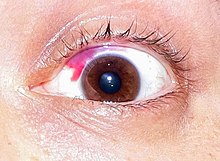Bleeding
A bleeding , even hemorrhage ( ancient Greek αἱμορραγία , blood flow, Hemorrhage , of αἷμα , Blood , latinisiert: haemorrhagia ), the leakage of blood from any region of the blood or of the blood circuit . Bleeding is possible from all vessels in the body or pulmonary circulation .
Bleeding can leak out of the body or bleed into the body ( internal bleeding ). As a result of bleeding, a hematoma (bruise) can form.
If the blood loss is large ( hypovolemia ), it can very quickly lead to shock and eventually death ( bleeding to death ). This may include hemorrhages solely from the capillaries , as haemorrhagic fever (z. B. Marburg fever or Ebola fever ), be the case.
An increased tendency to bleed is called hemorrhagic diathesis . According to the size, a distinction is made between punctiform ( petechiae ), patchy ( ecchymoses ), coin-sized ( sugillations ) and large-scale bleeding ( suffusions ).
Measures to stop bleeding
Bleeding wounds must first be covered with a wound pad. Any foreign bodies in the wound should be padded and their removal should be left to qualified personnel. In the case of heavy bleeding, which occurs especially when a larger artery (artery) or a larger vein (blood vein) is injured , it may also be necessary to apply a pressure bandage .
If this does not stop the bleeding, it may be necessary to compress arteries proximal to the bleeding. The setting is used when no adequate hemostasis can be achieved by pressure.
Under certain circumstances, minor bleeding can remain untreated. Since the bleeding has a wound-cleaning effect, the risk of wound infections is reduced . In no case should wounds be washed out.
Death by bleeding to death
In the event of a rupture of the aorta and the associated rapid collapse of the blood circulation , death occurs within a few seconds. If blood loss is slow, it can take a few hours for the injured person to go through all stages of hemorrhagic shock :
Given the volume of five to six liters of blood in a healthy, adult human, the lack of up to 0.75 liters of blood is usually not critical. One blood donation corresponds to about 0.5 liters. The loss of 1.5 liters leads to a feeling of thirst and weakness, breathing accelerates, and the person concerned feels fear. If you lose two liters of blood, you feel confused, dizzy and eventually lose consciousness. Due to the massive reduction in cardiac output , the blood circulation collapses.
Web links
Individual evidence
- ↑ S3- guideline for multiple trauma / treatment of seriously injured persons of the DGU . In: AWMF online (as of 07/2016)
- ^ Zeit Wissen, October / November 2008, p. 87.
